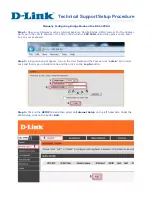
9
Authentication:
Authentication is a process in which the identity, e.g. of a person is determined based on a certain characteristic.
This can be done by fi ngerprint, password or any other proof of authorisation.
Encryption:
Encryption is a process in which plain text is transformed into a coded text via an encryption process (algorithm). One or
more codes can be used for this. It must also be mentioned that each individual encryption process offers one or more authentication
options.
The following encryption types are available for this mode:
•
64 Bit and 128 Bit WEP encryption
•
WPA and WPA2 encryption
You can make the settings under
Wireless/Security Settings
in the menu on the left for the
AP
mode.
Encryption is deactivated by default. However, for security reasons, we recommend
that you always use encryption.
3.2.2.1 WEP encryption
Wired Equivalent Privacy (
WEP
) is a standard encryption algorithm for WLAN. It both controls the access to the network and guaran-
tees the integrity of the data. This method is considered vulnerable due to a range of weaknesses.
First select whether you want to use 64 bit or 128
bit encryption. 128 bit encryption offers greater
security. Then select either Hex (characters
from 0-9 and a-f) or ASCII (any character) for the
Key Format
. This also determines the length of the
key.
Default Tx Key
allows you to select one of four
preset keys. Select
Key 1
, for example, and enter
your key of choice with the required length.
Examples:
64 bit Hex (10 characters) = 231074a6ef
64 bit ASCII (5 characters) = j31n.
128 bit Hex (26 characters) =
231074a6b9773ce43f91a5bef3
128 bit ASCII (13 characters) = urla0
Click
Apply
to save your settings. You must then restart the router for the settings to take effect. To do so, click
Apply
in the next
window. The wireless network with encryption is available after you restart.
3.2.2.2 WPA/WPA2 Encryption
Wi-Fi Protected Access
(WPA)
is an encryption method for WLAN. WPA contains the WEP architecture, but offers additional pro-
tection via dynamic codes, which are based on the Temporal Key Integrity Protocol (TKIP), and also offers pre-shared keys (PSK) or
extensible authentication protocol (EAP) for user authentication. However, a radius server is required for this. WPA2 is a development
of WPA and uses a different encryption algorithm, advanced encryption standard (AES).
WPA offers two types of authentication, either
pre-shared key
or authentication via special
authentication protocols
, which are
generally variations of EAP (Extensible Authentication Protocol). An authentication server (RADIUS server) is used for the latter
authentication method, which is rarely used for private applications. Your administrator can give you the information you require to
confi gure this authentication method.



































